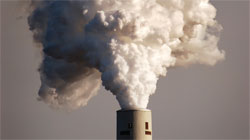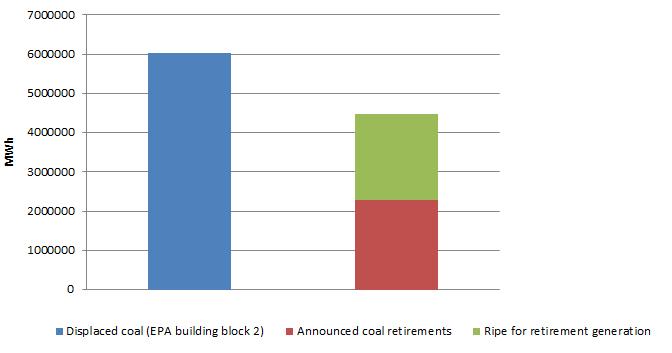On June 2, the EPA issued draft carbon standards for existing power plants. The standard sets state-specific goals for emissions rate reductions that are expected to add up to nationwide power sector emissions reductions of 30 percent below 2005 levels by 2030. We analyzed Virginia’s target and found that the state is well on track to meet – and can even exceed – its required goal.
Overall, nationally, UCS analysis shows that we could cost-effectively lower emissions by twice as much as the EPA’s draft standard requires, with renewable energy and energy efficiency playing a key role.
Virginia’s power sector today
Virginia’s dominant sources of electricity are its two nuclear power plants (North Anna and Surrey), which together supply 38% of the state’s electricity (EIA). The next biggest source is natural gas, followed by coal (see chart below).
Virginia’s emissions rate reduction target
This post is part of a series on the EPA Clean Power Plan.
Under the EPA’s proposal, Virginia is required to reduce its carbon emissions rate 38% below 2012 levels by 2030.
These reductions can come from four major building blocks, which states are free to combine in a flexible manner: heat rate (or boiler efficiency) improvements at existing coal-fired plants, shifting generation from coal to natural gas, generating electricity from low-carbon resources (including ramping up renewable energy and preserving nuclear generation that may be at risk of retiring), and increasing energy efficiency. The EPA made state-by-state estimates for each of these building blocks; however, the only binding target for a state is its overall emissions rate reduction.
Meeting the EPA’s standard
Virginia’s ability to meet the EPA’s draft standard rests on the fact that already a dominant share of its electricity comes from lower carbon sources including nuclear power, natural gas, and renewables.
Virginia receives credit for 6% of its nuclear fleet (a nationwide average for nuclear plants at risk for retirement) under the EPA’s formula for calculating emissions reduction targets. This amounts to 1,645 GWh.
In 2013, the state had 2,740 GWh of non-hydro renewable energy. Currently the state has a weak voluntary renewable electricity standard, set at 15% of the 2007 level of the state’s electricity from renewable sources by 2025 (approximately 1.1 MW of new renewable energy by 2030). If this goal is met, non-hydro renewables are projected to grow to at least 10,275 GWh by 2025, according to projections from the Lawrence Berkeley National Laboratory. In calculating Virginia’s emissions reduction goal, the EPA estimated that the state would achieve 11,192 GWh of renewable electricity by 2030. So under existing policies, the state is well on track to meet its renewable electricity goal.
The EPA also estimated that Virginia could achieve energy efficiency savings of 9.33% (in terms of avoided electricity sales) by 2029. The state currently has a voluntary energy efficiency goal of a savings of 10% by 2022; however, that is not currently on track to be met. Were the efficiency standard to be made mandatory, the state would achieve its efficiency goal ahead of time.
A number of coal-fired power plants in the state, with generation totaling 2,275 GWh, have recently been announced for retirement primarily because they are increasingly uncompetitive with cleaner forms of electricity. These include five units at the Potomac River coal plant (514 MW) closed in 2012 and another nine units (1,600 MW) at three plants (Chesapeake, Glen Lyn, and Yorktown) which are scheduled to retire in 2015.
Overall the retirements already announced are approximately equivalent to 38% of the amount of coal generation that is assumed to be displaced by natural gas according to the EPA’s calculations. Recent UCS analysis identified an additional 1,887 MW of coal-fired power in Virginia (amounting to 2,200 GWh of generation) that is uneconomic relative to existing natural gas combined cycle plants and could be considered for retirement.
Together, the announced and ripe for retirement generation gets Virgina three-quarters of the way toward meeting the amount of coal generation the EPA estimated would be displaced to meet the state’s 2030 emissions goal (see chart below).
Existing natural gas plants in Virginia were already being run at a fairly high (60%) capacity factor in 2012, so the opportunity to further switch from coal to gas is somewhat limited. In 2012, there was also nearly 2 GW of new natural gas capacity under construction in the state. However, an over reliance on natural gas as a compliance option comes with significant economic and climate risks. Diversifying the electricity mix by switching to more renewables will help reduce these risks.
Opportunities to further reduce Virginia’s carbon emissions
Virginia has significant opportunities to drive down its emissions through cost-effective investments in renewable energy and energy efficiency. If the state were to adopt a mandatory, more ambitious renewables goal, it could achieve deeper reductions. For example, just next door, DC has a renewable electricity standard of 20% by 2020 and Maryland has a standard of 20% by 2022. The state has significant wind and solar energy potential — 4,589 GWh of wind and 1.9 million GWh of utility-scale solar, according to NREL data cited by the EPA.
A recent study by ACEEE shows that the state could go much further in its energy efficiency goals, achieving a 23 percent reduction in electricity consumption in 2030 relative to 2012 by implementing an energy efficiency savings target combined with national model building codes, investments in combined heat and power systems (CHP), and equipment efficiency standards.
The state could also be an important site for offshore wind development. Dominion Virginia Power recently won a Department of the Interior lease for an area off Virginia Beach that could support 2 GW of offshore wind, and $47 million from the Department of Energy to develop a 12 MW demonstration plant.
Coal mining in Virginia
Although Virginia’s coal industry has been in economic decline, it still has several coal mines, mainly in the southwestern part of the state including Buchanan and Wise counties, which together provide employment to approximately 5,000 miners. However, EIA projections show that, even under business as usual, coal from Virginia is likely to become increasingly uncompetitive compared with coal from Wyoming and the interior coal fields of Indiana, Illinois, and western Kentucky. In addition, low natural gas prices are putting pressure on coal demand nationwide.
As these economic factors combine with the nation’s continuing transition to cleaner, cheaper forms of electricity, it is imperative to make investments in transition assistance for coal miners. Funds for this could come from state severance taxes or, potentially, a price on carbon.
Coastal Virginia on the front lines of sea level rise
Virginia’s coast faces extremely high risks of flooding due to sea level rise and worsening storm surge. The lower Chesapeake Bay region has experienced some of the fastest rates of sea level rise (3.6 to 7.0 mm per year) on the eastern seaboard, and is also home to 60% of the state’s 8.2 million residents. Norfolk has seen 10.5 inches of local sea level rise over the last 50 years. For planning purposes, the Virginia Institute of Marine Science recommends anticipating sea level rise of an additional 18 inches within the next 20 to 50 years.
The Norfolk-Hampton roads region already experiences routine flooding during high tides. It is also home to Naval Station Norfolk, the largest naval base in the world – and site of the state’s largest (2 MW) solar PV facility. As my colleague, Adam Markham, writes, Norfolk and surrounding towns are all already dealing with significant costs of flooding, and the city has spent millions to raise roads, build flood defenses, and improve storm-water management.
Ironically, the seaport at Norfolk is also the nation’s largest coal export facility, handling nearly 40% of U.S. coal exports in 2012.
Add your voice in support of strong power plant carbon standards
On July 29 and 30 the EPA is scheduled to hold public hearings on the draft carbon standards in Washington, DC, Denver, CO, and Atlanta, GA, followed by hearings on July 31 and August 1 in Pittsburgh, PA. Please add your voice in support of strong standards that include a significant role for renewables and efficiency, in person at the hearings or online.
If you’re from the Commonwealth of Virginia, now you know your state can definitely meet and even exceed the standard – and it desperately needs ambitious efforts to cut carbon emissions to help slow the pace of climate change and sea level rise.



